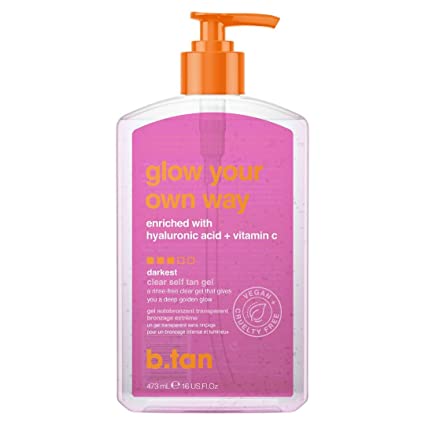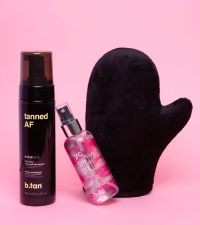Experience a flawless and natural-looking tan with b.tan Clear Self-Glow Your Way Tanning Mousse. Our paraben-free formula is designed to give you a long-lasting, streak-free tan that will leave you feeling confident and radiant. Whether you’re a tanning pro or a beginner, our self-tanning mousse is easy to apply and provides a beautiful, sun-kissed glow without the harmful effects of UV rays.
- A brief explanation of the rising popularity of self-tanning products
- Importance of choosing the right self-tanning product
- Overview of the article’s content
Understanding Self-Tanning Products
What are self-tanning products?
- Definition and explanation of self-tanning products
- Different types of self-tanning products (lotions, mousses, sprays, wipes, etc.)
- Benefits of using self-tanning products
How do self-tanning products work?
- Explanation of the active ingredient in self-tanners (DHA)
- Interaction between DHA and the amino acids in the skin
- Development of the tan and its longevity
Pros and cons of self-tanning products
| Pros | Cons |
| Achieving a natural-looking tan without exposure to harmful UV rays Convenient and cost-effective alternative to professional tanning methods The customizable tan intensity and control over the application. | Achieving a natural-looking tan without exposure to harmful UV rays Convenient and cost-effective alternative to professional tanning methods The customizable tan intensity and control over the application. |
Factors to Consider When Choosing a Self-Tanning Product
Skin Type and Tone
- Explanation of different skin types (dry, oily, combination, sensitive) and their compatibility with self-tanning products
- How to determine your skin tone (cool, warm, neutral) for selecting the right shade
- Recommendations for self-tanning products based on skin type and tone
Application Method
- Comparison of different application methods (lotions, mousses, sprays, wipes)
- Advantages and disadvantages of each method
- Tips for proper application to achieve an even tan

Formula and Ingredients
- Common ingredients in self-tanning products (DHA, moisturizers, botanical extracts)
- Understanding ingredient labels and potential allergens
- Choosing products with skin-nourishing ingredients and avoiding harmful additives
Longevity and Fade
- Factors that affect the longevity of a self-tan (product formulation, skin preparation, aftercare)
- Understanding the fading process and avoiding patchiness
- Recommendations for long-lasting self-tanning products
Scent
- Explanation of the characteristic odor associated with self-tanning products
- Introduction to scented and unscented options
- Tips for minimizing the scent and choosing products with pleasant fragrances
Finding the Perfect Self-Tanning Product for You
Researching Brands and Products
- Importance of researching before purchasing
- Popular self-tanning brands and their product offerings
- Reading customer reviews and testimonials
Testing and Sampling
- Importance of testing a product before committing to it
- Availability of sample sizes or testers
- How to perform a patch test and assess color development
Seeking Recommendations
- Asking friends, family, or beauty professionals for recommendations
- Seeking advice from online communities, forums, or social media groups
- Importance of considering individual preferences and skin types
Considering Price and Value
- Comparison of self-tanning product prices and sizes
- Evaluating the value based on product quality and longevity
- Tips for finding affordable options without compromising on quality
Tips for Achieving a Flawless Self-Tan
Preparing Your Skin
- Exfoliation and removal of dead skin cells
- Moisturizing dry areas and rough patches
- Shaving or waxing before self-tanning
Proper Application Techniques
- A step-by-step guide to applying self-tanning products
- Blending techniques for even coverage
- Special considerations for hard-to-reach areas
Maintenance and Aftercare
- Tips for prolonging the life of your self-tan
- Hydrating the skin to prevent dryness and flaking
- Avoiding activities that may prematurely fade the tan (excessive sweating, swimming, harsh exfoliation)
Troubleshooting Common Issues
- Addressing streaks and uneven color
- Fixing orange undertones or dark spots
- Emergency solutions for last-minute tanning mishaps
Conclusion
- Recap of the importance of choosing the right self-tanning product
- Encouragement to experiment and find the perfect product for individual needs
- Final thoughts on the benefits of self-tanning and maintaining a healthy glow
FAQs
explanation of the suitability of self-tanning for sensitive skin types
Tips for choosing gentle formulas and performing patch tests
Discussion of using self-tanners on the face and precautions to take
Recommendations for face-specific self-tanning products
Explanation of the typical lifespan of a self-tan (5-7 days)
Factors that can influence the longevity of a self-tan
Addressing the misconception that self-tanning is exclusively for women
Recommendations for self-tanning products suitable for men
Discussion of the safety of self-tanning products during pregnancy
Recommended Precautions and considerations for pregnant individuals
